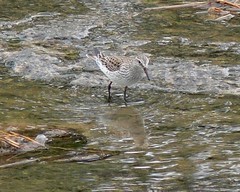
I was most excited to find 4 White-rumped Sandpipers and 4 Pectoral Sandpipers on the creek. In the right habitat, both are common spring migrants in central Texas. And Pectoral Sandpipers are not too uncommon on our creek during the spring. But I have only seen White-rumped Sandpipers a handful of times in the neighborhood. My pictures don't do them justice. Their subtle silvery grey and white and black plumage is accented by just a few flecks of reddish brown. When they fly you can see their white rump. These are some of the farthest migrating birds in the western hemisphere, wintering in southern-most South America and breeding in the Canadian Arctic. I'm glad a few could stop and refuel on our creek. In the photo below, a Pectoral is on the left (with the yellow legs) and a White-rumped is resting on the right.

The woods along the creek was full of flycatchers, mostly Eastern Wood-Pewees and birds in the Empidonax genus (empids). This genus is infamous for being difficult to identify down to species. The easiest way is by the birds' songs, and a few were vocal this morning. So I was able to identify at least 2 Least Flycatchers, 1 Alder Flycatcher, and 1 Willow Flycatcher. I estimated I saw 8 or 10 empids all together.
In the same woods I found 6 species of warblers. There were at least 4 female American Redstarts foraging and flaring their tails in the willow trees, along with a Yellow Warbler. In the dense woods off the trail I found a female Canada Warbler. And back along the sidewalk In a narrow strip of woods by the creek I found a Wilson's Warbler, a beautiful Magnolia Warbler, and a singing male Mourning Warbler. What a fun morning!

No comments:
Post a Comment